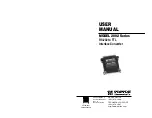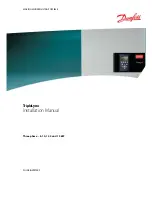
IN1608 xi Scaling Presentation Switcher • Operation
46
RS-232 protocol
You also may need to set the RS-232 protocol of the addressed port to match the connected
device. You can do this using any of the following methods:
•
Using the Product Configuration Software (see the
IN1606 and IN1608 Series PCS Help
file).
•
SIS commands on page 75).
•
Using the internal web page (see
Baud Rate, Data Bits, Stop Bits, and Parity
page 124.
Captive Screw Signal Insertion
Figure 35 is an example of a typical captive screw insertion, in which an Extron IPCP module
provides control of a Blu-Ray player via the scaler. Configure this type of insertion as follows:
NOTE:
Each captive screw insert is for the associated input or output only and cannot
be tied to any other input or output.
1.
Connect an RS-232 cable from the IPCP module to the RS-232 captive screw port
(input port 8 in this example).
2.
If necessary, enable the port for captive screw (see
The RS-232 control signal is inserted directly onto the TP port of the same number and
cannot be tied to any other port.
3.
Connect the TP cable to the endpoint as usual.
4.
Connect a serial cable from the endpoint to the device to be controlled.
100-240V ~ 1.5 A MAX
1
2
CONFIGURABLE
HDMI
HDMI
5
6
7
8
1C
RS-232 IR
Tx Rx
Tx Rx
G
Tx Rx
Tx Rx
G
Tx Rx
Tx Rx
G
HDMI
1A
1B
3
4
INPUTS
OUTPUTS
Tx Rx
RS-232
G
2x25W(8Ω)/2x50W(4Ω)
RESET
AUDIO INPUTS
OUTPUTS
REMOTE
L
L
1
R
R
L 2
R
L
3
R
CLASS 2 WIRING
L
4
R
L
5
R
+48V
+48V
1
2
L
R
VARIABLE
IN1608 xi IPCP SA
2
MIC/LINE
L
6
R
SIG LINK
DTP IN
SIG LINK
DTP IN
SIG LINK
DTP OUT
50/60 Hz
RS-232
IR
OVER DTP
OVER DTP
AMPLIFIED OUTPUT
DTP
HDBT
Tx Rx
RTS CTS
G
Tx Rx G Tx Rx G
LAN
AV LAN 2
AV LAN 3
AV LAN 1
1 2 3 4 G
DIGITAL I/O
COM 3
COM 2
COM 1
S
S
G
G
1
1
2
2
C
3 4 C
-S G
+S
+V
PWR OUT = 6W
IR/SERIAL
eBUS
RELAYS
DTP IN
Network
AUDIO
INPUTS
OVER DTP
RS-232
IR
Tx Rx
Tx Rx
G
POWER
12V
0.7A MAX
SIG LINK
DTP OUT
DTP HDMI 4K 230 Tx
RS-232
Insertion
RS-232
RS-232
IN1608 xi IPCP SA
Blu-Ray Player
TM
FULL HIGH DEFINITION 1080P VIDEO OUTPUT
BLU-RAY DISC PLAYER
Figure 35.
Typical Captive Screw Insertion to an Input Endpoint
















































